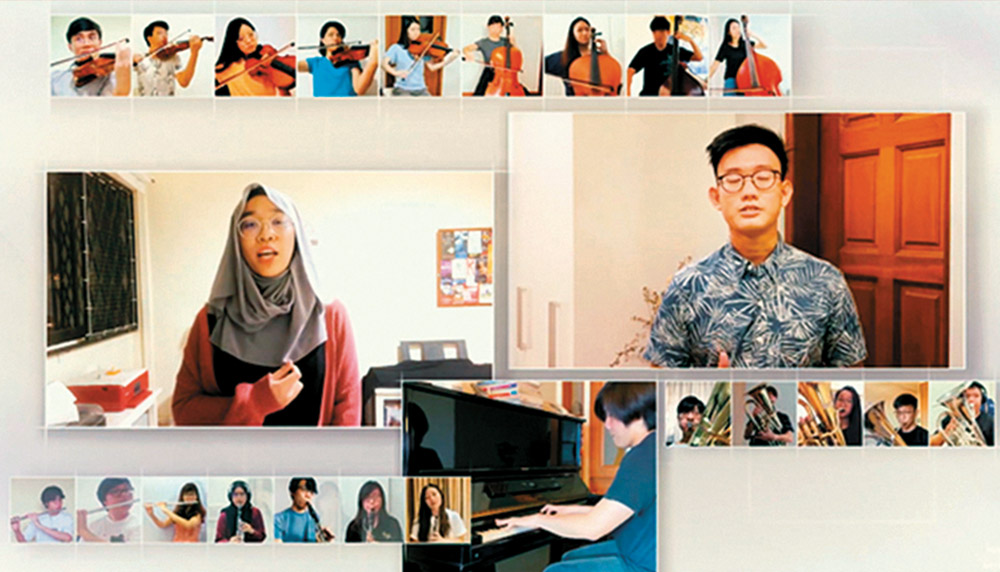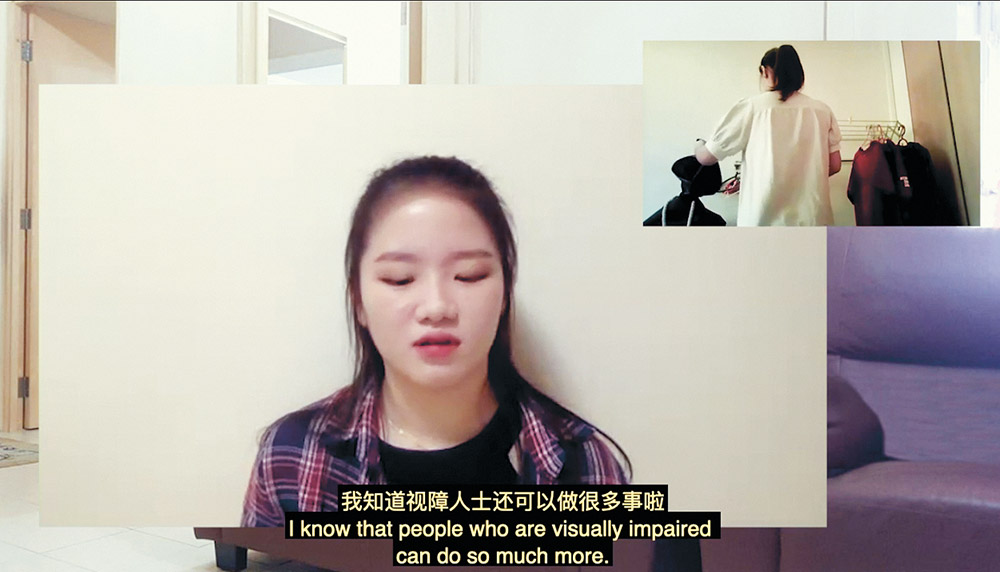A Digital Transformation of the Performing Arts
In the light of social distancing restrictions caused by the pandemic, creative expression on campus gets a new lifeline in the virtual space.
 A look behind-the-scenes at members from the EMCC Crew with their audio-visual equipment as they support a video recording for an online production.
A look behind-the-scenes at members from the EMCC Crew with their audio-visual equipment as they support a video recording for an online production.
Every June to August — just before the start of the academic year — the NUS campus bustles with life as it welcomes newly-matriculated freshmen through orientation camps, hall activities, the Student Life Fair and the annual HERE! Arts Carnival. Organised by NUS Centre For the Arts (CFA), the carnival is where freshmen are introduced to the arts offerings on campus. All this changed with the onset of COVID-19. In February 2020, the NUS Arts Festival was cancelled as social distancing measures were implemented, and live performances ceased, while student artists were not allowed to rehearse together. All at once, the vibrant roar generated from the University’s arts scene was dampened to a whisper.
Yet, the passion for the arts, backed by the power of the internet, has found ways to rise above the challenges. Led by Ms Jobina Tan from CFA, with the support of seven students who were part of the CFA Ambassadors Programme, the 2020 HERE! Arts Carnival went digital with a slew of exciting online offerings. The opening event was a virtual performance of ‘When You Believe’ from The Prince of Egypt by a music, drama and dance ensemble, featuring all 21 CFA Arts Excellence Groups. The project was wholly owned by the students, who arranged the work, choreographed the dance, and performed a tapestry of 200 separate elements. In essence, it served as an expression of the solidarity among student artists with different talents and proved inspiring to their audience.
 A screenshot of When You Believe, a collaborative montage by students from the CFA Arts Excellence Groups.
A screenshot of When You Believe, a collaborative montage by students from the CFA Arts Excellence Groups.
This initial foray into digital presentation has since led to new and exciting ways for the students to surmount the challenges of performing in these uncertain times. The play Blindspot was originally programmed as part of NUS Arts Festival 2020. When the festival was cancelled, the students decided to present the show online. They were forced to review what ‘accessibility’ meant as the audience was no longer physically present. The other challenge was that cast members had become scattered across the world. Using only Zoom to rehearse and film their individual parts, the students then edited and pieced the footage together on Adobe Premiere. To aid hearing-impaired viewers, they also translated speech to text and included closed captions. An audio description version was separately prepared to cater to the visually-impaired. While the students were not new to the use of technology — in video editing, for example — the extent to which their skills were creatively interwoven into their productions has increased tremendously in the last year. Blindspot thus marked the first accessible online production to be virtually staged by a Chinese-language youth theatre group in Singapore. This same ingenuity was seen in NUS Arts Festival 2021: A Question of Time, where a combination of 18 live performances and 27 digital shows blurred the line between physical and virtual arts experiences through hybrid performances, online video games, interactive presentation of text, and an augmented-reality (AR) installation.
 A snippet from Blindspot, a live theatre production by NUS Chinese Drama.
A snippet from Blindspot, a live theatre production by NUS Chinese Drama.
Blurring the boundaries
Among the Opening Night performances of NUS Arts Festival 2021 was Past. Presence. Future. by the NUS Dance Ensemble (NUSDE). Choreographed by Artistic Director Mr Zaini Mohammad Tahir (Arts and Social Sciences ’89), it featured an original composition by Mr Tan E-Reng, a current English Literature major and President of NUS Electronic Music Lab. The performance fused elements of dance theatre, film and photography into the narrative of a family’s journey through time and memories.
Filmed during Singapore’s Phase 3 of safe management measures, the challenge was to create a work which could be viewed either solely as a virtual performance or a live work that integrated the cinematic elements into an experience that would resonate with audiences, regardless of the space they occupied. But first, the technology had to take in the human factor of the performers investing themselves into the work.
Ms Erika Goh, a current Engineering student and NUSDE’s President and Dance Captain, shared, “It was definitely a challenging piece, given how previous productions involved more artistic interactivity through elements such as body contact and pas de deux, to culminate in a single performance on stage to a live audience. For Past. Presence. Future., however, we had to recreate the same energy without contact on stage and perform with that energy repeatedly when filmed. It was crucial that our facial expressions were projected well and accurately, given how close the camera was to us. We also needed to maintain clean lines in our movements to accommodate whichever angle the camera approached with, across many takes.”
![]()
Our foray into the digital sphere has brought onboard a new subset of students keen on supporting their performing arts peers through their own digital skills.
Ms Mary Loh, Head of Talent, Development and Programming at CFA
Ms Goh found the experience a very rewarding one. “In a year of disconnect from NUS, I found Past. Presence. Future. a great outlet for me to really dig deep into my emotions to reflect on the time we have with our loved ones and on reconnecting with ourselves — concepts which were universal to those affected by the pandemic,” she said. “I felt more connected with NUS through this production as it helped me reflect on my NUS experiences and bond with other performers and NUSDE dancers.”
Another unique collaboration involved CFA with the NUS School of Computing in an AR installation titled A Mo(ve)ment in Time. Set up as a photo exhibition at UTown’s Stephen Riady Centre, the installation invited viewers to view still pictures of productions using an app created by Computing students which brought the photos to life. “In a time when audiences are robbed of engaging with performance arts physically, it served as a window through time, showcasing artistic performances from the past,” explained Mr Jonathan Heng from CFA. “When ideating this installation, we explored the possibilities of AR with Dr Anand Bhojan (Computing (PhD) ’13) from the NUS School of Computing. We saw an opportunity for synergy, and he was happy to integrate our programme into the coursework for his module.” The integration of arts with technology is an important step for CFA and an evolving part of future education, echoing NUS President Professor Tan Eng Chye’s (Science ’85) call to transform the NUS educational experience through an interdisciplinary approach where students “[integrate] knowledge, skills and insights from different disciplines.”
 Past. Presence. Future.
Past. Presence. Future.
Developing the new artistic skill set
Echoing this sentiment is Ms Mary Loh (Arts and Social Sciences ’86), Head of Talent, Development and Programming at CFA. “Over the past year, our students have grown to realise that a digital performance is not merely a video rendering of a live show but an opportunity to experiment, collaborate and create something larger than the sum of its parts,” she said. “Although the students begin with their chosen art form, they often quickly discover that they require different creative skills and the support of different partners to create this entity on a virtual stage. Whether or not they are conscious of the milestones, our student artists are evolving new forms of work that defy strict classification in any one genre.” She added that to support these students, CFA conducts regular training in digital media skills like video-making, digital broadcasting and digital marketing.
The members of one of CFA’s Arts Excellence Groups, the ExxonMobil Campus Concerts (EMCC) Crew, have further developed technical competencies and adapted their learning to present the concerts and support the artistic fraternity. President of EMCC Crew, Ms Siow Yun Jing, an Arts and Social Sciences student, shared, “Due to the COVID-19 restrictions, there were more considerations when planning production support, such as having to work within the five-person limit. With shows moving online, we also introduced new roles in production support such as livestream operator and camera operator. Remote roles were introduced such as livestream moderators — similar to Front-of-House roles — where crew members operated the livestream chat remotely from home.”
On the whole, the process of digital transition has opened up many possibilities for the NUS arts community. “We cannot be more proud of the students in the CFA groups for rising above the many constraints and challenges, to continue to pursue their passion and to express their creativity,” said Ms Sharon Tan (Arts and Social Sciences ’88), Director of CFA. “We have seen them take greater ownership of their learning and observed their growing confidence in embracing other disciplines. They have not only taken on board the theme of this year’s Arts Festival, A Question of Time, but have also cleverly optimised the new hybrid presentation to reflect the many dimensions of time-space. It is this ability to wade into the unknown and to make meanings out of it that will put them in good stead for the future.”
Watch the NUS Arts Excellence Groups’ montage of
When You Believe at
bit.ly/cfa-wyb